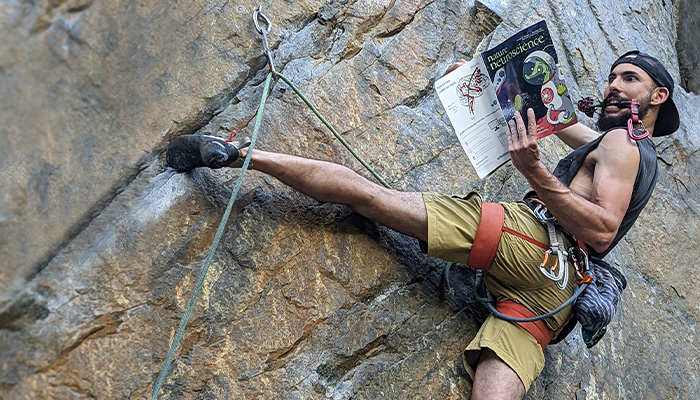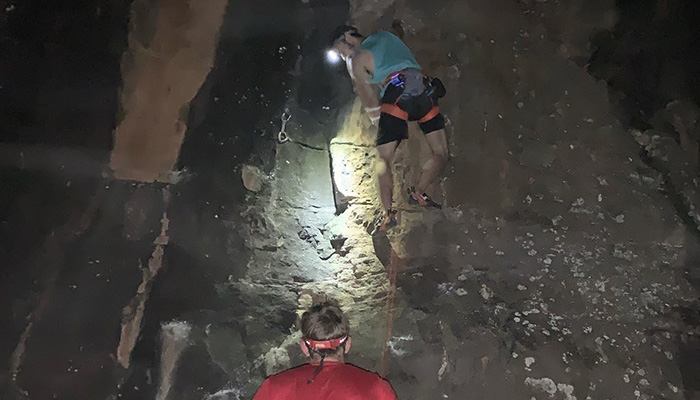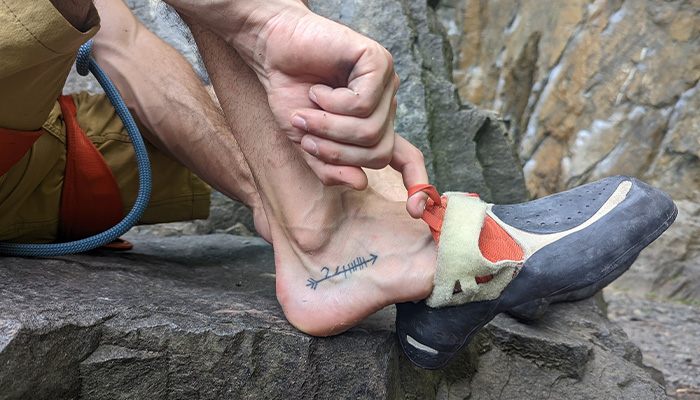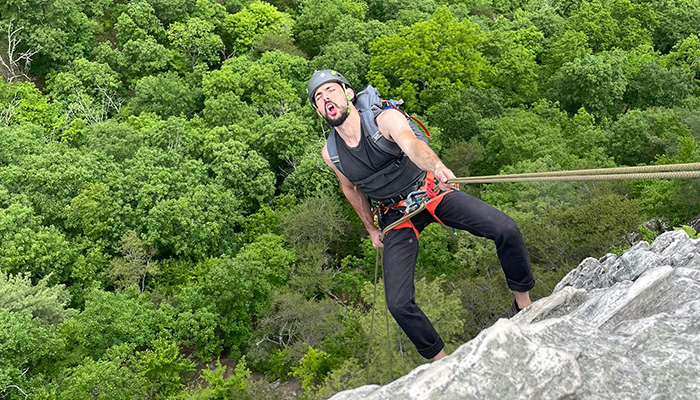HOW CAN WE HELP YOU? Call 1-800-TRY-CHOP
In This Section
Scaling New Heights as a Scientist and Competitive Rock Climber

A self-proclaimed “adrenaline junkie,” Dr. Kiffer learned to rock climb when he was in college in the eastern foothills of the Ozark Mountains.
Frederico (Fred) Kiffer, PhD, is no stranger to working long focused hours in a laboratory. With two postdoctoral fellowships at Children's Hospital of Philadelphia, first through the NASA-instituted Translational Research Institute for Space Health, and now as a postdoc diversity fellow in the Eisch Lab, Dr. Kiffer assesses the effects of space radiation on the brain, with funding from NASA. He then bridges that knowledge to the clinic by investigating how particle radiotherapy can improve therapeutic outcomes in an aggressive pediatric brain cancer while sparing non-cancerous tissues from radiation toxicities.
But once Dr. Kiffer doffs his white lab coat and leaves his biomedical research behind, his focus shifts to fulfilling his "other side."
"I need to be doing something crazy and physical and mentally challenging by pushing my limits in a different way," Dr. Kiffer said.
Competitive Rock Climbing

Climbing in the middle of the night, while moral was still high, during the 24 Hours of Horseshoe Hell event.
A self-proclaimed "adrenaline junkie," Dr. Kiffer learned to climb when he was an undergraduate student at Lyon College, located in the eastern foothills of the Ozark Mountains. Although he did it just for fun to hang out with his friends, Dr. Kiffer said rock climbing is a demanding sport — physically and mentally — that tests a climber's endurance, strength, balance, and mental control. Both the use of specialized climbing equipment and knowledge of proper climbing techniques are critical for safely completing routes.
After graduating from college, he became more involved with the rock climbing community and started competing, which led him to an endurance rock climbing competition called 24 Hours of Horseshoe Hell. It's a competition and festival held annually in late September within the steep sandstone cliff walls of a ranch in Jasper, Arkansas.
As "24 hours" would suggest, there's no sleeping, bathroom breaks involve a "squatty potty," and food consists of backpack burritos and plenty of water and electrolyte mix.
Outfitted in costumes of their choosing, teams of two enter competitions, such as most amount of vertical mileage, most difficult routes, best haircut, best costume, and overall number of climbed routes. The average route is 30 meters, which is just about 100 feet tall and comparable to a 10-story building.
"The vertical mileage category is a big deal," Dr. Kiffer said. "It's a huge achievement to climb a vertical mile in 24 hours."
It puts the climber in the exclusive "mile high club" and earns them a T-shirt. Dr. Kiffer has several. And after the 24 hours of climbing is complete, competitors may choose to wipe off the mud, blood, sweat, and tears and mark their achievement with a tattoo. Dr. Kiffer has one.

Dr. Kiffer celebrates his achievement with a tattoo.
In 2021, in both the individual and team event, Dr. Kiffer took second place in the intermediate category for most points, which is a combination of the amount of routes climbed and their difficulty.
Last year, Dr. Kiffer's team wasn't so lucky, as his climbing partner was bitten by a bat — yes, a bat — as he reached in for a hold. They had to quickly leave the "out in the middle of nowhere" competition in search of a medical center to get a rabies shot. They plan to re-enter the event in 2024.
A Supportive Community

Repelling down a multi-pitch route at Seneca Rocks in West Virginia.
When not competing in the Ozarks, Dr. Kiffer continues his adrenaline pumping hobby in local rock climbing gyms as well as the great outdoors. The really good climbing in the region is in West Virginia and New York State, Dr, Kiffer said. So whenever he gets the chance to take more than two days off from work, Dr. Kiffer heads to the New River Gorge in West Virginia or "the Gunks," aka the Shawangunk Mountains in southeastern New York, one of the premier climbing areas in the country.
As rock climbing tends to be a group activity, Dr. Kiffer ventures out with a group of friends or people he meets in the climbing gyms or "out in the wild."
"There's a lot of hanging out and supporting each other," Dr. Kiffer said. "It's about personal growth. Everyone is climbing their own route and pushing their own boundaries. It's a community-based thing where we support each climber on their own struggle.
"If anyone reading this wants to go climbing," Dr. Kiffer said, "I'll be happy to take you."


